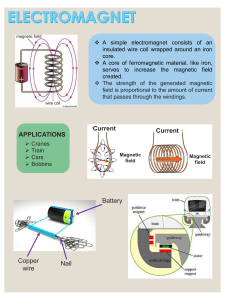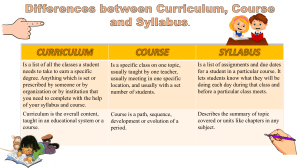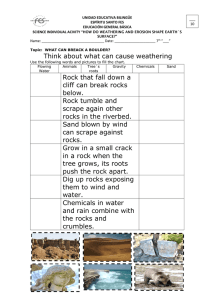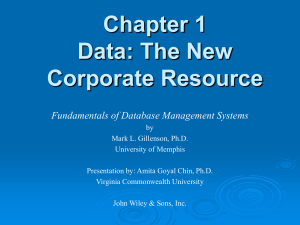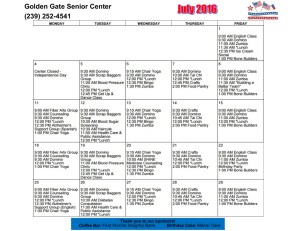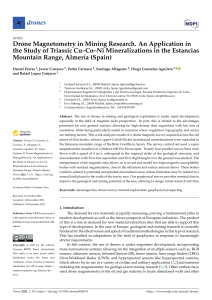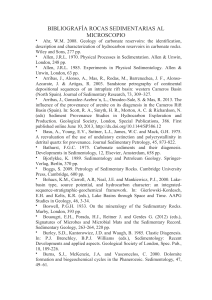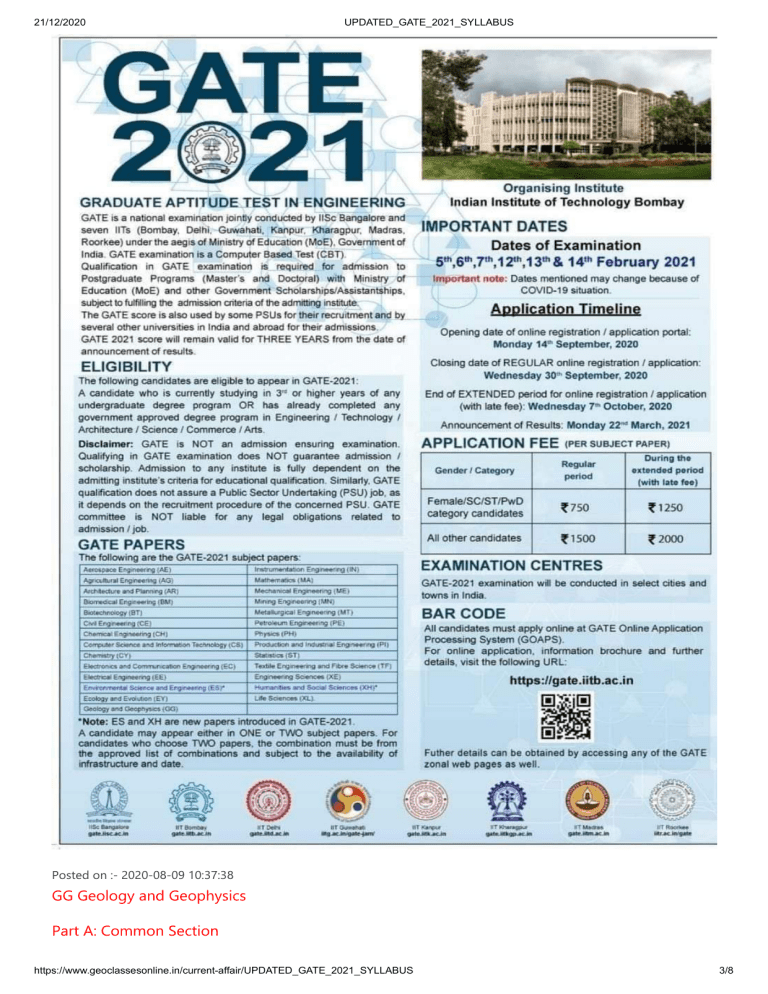
21/12/2020 UPDATED_GATE_2021_SYLLABUS Posted on :- 2020-08-09 10:37:38 GG Geology and Geophysics Part A: Common Section https://www.geoclassesonline.in/current-affair/UPDATED_GATE_2021_SYLLABUS 3/8 21/12/2020 UPDATED_GATE_2021_SYLLABUS Earth and planetary system – terrestrial planets and moons of the solar system; size, shape, internal structure and composition of the earth; concept of isostasy; elements of seismology – body and surface waves, propagation of body waves in the earth’s interior; Heat flow within the earth; Gravitational field of the Earth; geomagnetism and paleomagnetism; continental drift; plate tectonics – relationship with earthquakes, volcanism and mountain building; continental and oceanic crust – composition, structure and thickness. Weathering and soil formation; landforms created by river, wind, glacier, ocean and volcanoes. Basic structural geology - stress, strain and material response; brittle and ductile deformation; nomenclature and classification of folds and faults. Crystallography – basic crystal symmetry and concept of point groups. Mineralogy – silicate crystal structure and determinative mineralogy of common rock-forming minerals. Petrology of common igneous, sedimentary and metamorphic rocks. Geological time scale; Geochronology and absolute time. Stratigraphic principles; major stratigraphic divisions of India. Mineral, coal and petroleum resources of India. Introduction to remote sensing. Engineering properties of rocks and soils. Elements of hydrogeology. Principles and applications of gravity, magnetic, electrical, electromagnetic, seismic and radiometric methods of prospecting for oil, mineral and groundwater; introductory well logging. Part B (Section-1): Geology Geomorphology - Geomorphic processes and agents; development and evolution of landforms in continental and oceanic settings; tectonic geomorphology. Structural geology – Forces and mechanism of rock deformation; primary and secondary structures; geometry and genesis of planar and linear structures (bedding, cleavage, schistosity, lineation); folds, faults, joints and unconformities; Stereographic projection; shear zones, thrusts and superposed folding; basement cover relationship. Interpretation of geological maps. Crystallography and mineralogy- Elements of crystal symmetry, form and twinning; crystallographic projection; crystal chemistry; classification of minerals, physical and optical properties of rock-forming minerals. Geochemistry – Cosmic abundance of elements; meteorites; geochemical evolution of the earth; geochemical cycles; distribution of major, minor and trace elements in crust and mantle; elements of high temperature and low-temperature geochemical thermodynamics; isotopic https://www.geoclassesonline.in/current-affair/UPDATED_GATE_2021_SYLLABUS 4/8 21/12/2020 UPDATED_GATE_2021_SYLLABUS evolution of the crust and the mantle, mantle reservoirs; geochemistry of water and water-rock interaction. Igneous petrology – Classification, forms, textures and genesis of common igneous rocks; magmatic differentiation; binary and ternary phase diagrams; major and trace elements as monitors of partial melting and magma evolutionary processes. Mantle plumes, hotspots and large igneous provinces. Sedimentology– Texture, structure and sedimentary processes; petrology of common sedimentary rocks; Sedimentary facies and environments, cyclicities in sedimentary succession; provenance and basin analysis. Important sedimentary basins of India. Metamorphic petrology – Structures and textures of metamorphic rocks. Physico-chemical conditions of metamorphism and concept of metamorphic facies, grade and baric types; chemographic projections; metamorphism of pelitic, mafic and impure carbonate rocks; role of bulk composition including fluids in metamorphism; thermobarometry and metamorphic P-T-t paths, and their tectonic significance. Paleobiology - Diversity of life through time, mass extinctions- causes and effects; taphonomy processes of fossilization. Taxonomy. Morphology and functional morphology of invertebrates (bivalves, brachiopods, gastropods, echinoids, ammonites); microfossils (foraminifera, ostracoda, conodonts, bryozoa); Vertebrate palaeontology (Equus, Probicidea, Human); Paleobotany (plant, spores, pollens). Basic concepts of ecology/paleoecology; classification - ecological and taxonomic schemes (diversity and richness). Fossils and paleoenvironments. Stratigraphy – Principles of stratigraphy and concepts of correlation; Lithostratigraphy, biostratigraphy and chronostratigraphy. Principles of sequence stratigraphy and applications. Stratigraphy of peninsular and extra-peninsular India. Boundary problems in Indian stratigraphy. Resource geology - Ore-mineralogy; ore-forming processes vis-à-vis ore-rock association (magmatic, hydrothermal, sedimentary, supergene and metamorphogenic ores); fluid inclusions as ore genetic tools. Coal and petroleum geology; marine mineral resources. Prospecting and exploration of economic mineral deposits - sampling, ore reserve estimation, geostatistics, mining methods. Ore dressing and mineral economics. Distribution of mineral, fossil and nuclear fuel deposits in India. Global tectonics – Plate motions, driving mechanisms, plate boundaries, supercontinent cycles. Applied geology – Physico-mechanical properties of rocks and soils; rock index tests; Rock failure criteria (Mohr-Coulomb, Griffith and Hoek-Brown criteria); shear strength of rock discontinuities; rock mass classifications (RMR and Q Systems); in-situ stresses; rocks as construction materials; geological factors in the construction of engineering structures including dams, tunnels and excavation sites. Analysis of slope stability. Natural hazards (landslide, volcanic, seismogenic, coastal) and mitigation. Principles of climate change. https://www.geoclassesonline.in/current-affair/UPDATED_GATE_2021_SYLLABUS 5/8 21/12/2020 UPDATED_GATE_2021_SYLLABUS Hydrogeology – Groundwater flow and exploration, well hydraulics and water quality. Basic principles of remote sensing – energy sources and radiation principles, atmospheric absorption, interaction of energy with earth’s surface, aerial-photo interpretation, multispectral remote sensing in visible, infrared, thermal IR and microwave regions, digital processing of satellite images. GIS – basic concepts, raster and vector mode operations. Part B (Section-2): Geophysics Solid-Earth Geophysics - The earth as a planet; different motions of the earth; gravity field of the earth, Clairaut’s theorem, size and shape of earth; geomagnetic field, paleomagnetism; Geothermics and heat flow; seismology and interior of the earth; variation of density, velocity, pressure, temperature, electrical and magnetic properties of the earth. Geodesy - Gravitational Field of the Earth; Geoid; Ellipsoid; Geodetic Reference Systems; Datum; Everest (1830) and WGS 84 (1984) systems; GPS and DGPS; Levelling and Surveying. Earthquake Seismology - Elements of elasticity theory- stress and strain tensors, Generalized Hooke’s Law; Body and Surface Waves; Rotational, dilatational, irrorational and equivolumnal waves. Reflection and refraction of elastic waves; Inhomogenous and evanescent waves and bounded waves; Eikonal Equation and Ray theory; earthquakes-causes and measurements, magnitude and intensity, focal mechanisms; earthquake quantification, source characteristics, seismotectonics and seismic hazards; digital seismographs, Earthquake statistics, wave propogation in elastic media, quantifying earthquake source from seismological data. Elements of Seismic Tomography. Potential and Time Varying Fields - Scalar and vector potential fields; Laplace, Maxwell and Helmholtz equations for solution of different types of boundary value problems in Cartesian, cylindrical and spherical polar coordinates; Green’s theorem; Image theory; integral equations in potential and time-varying field theory. Gravity Methods - Absolute and relative gravity measurements; Gravimeters; Land, airborne, shipborne and bore-hole gravity surveys; Tensorial Gravity sensors and surveys; various corrections for gravity data reduction – free air, Bouguer and isostatic anomalies; density estimates of rocks; regional and residual gravity separation; principle of equivalent stratum; data enhancement techniques, upward and downward continuation; derivative maps, wavelength filtering; preparation and analysis of gravity maps; gravity anomalies and their interpretation – anomalies due to geometrical and irregular shaped bodies, depth rules, calculation of mass. Magnetic Methods - Elements of Earth’s magnetic field, units of measurement, magnetic susceptibility of rocks and measurements, magnetometers and magnetic gradiometers, Land, airborne and marine magnetic and magnetic gradiometer surveys, Various corrections applied to magnetic data, IGRF, Reduction to Pole transformation, Poisson’s relation of gravity and magnetic potential field, preparation of magnetic maps, upward and downward continuation, magnetic anomalies due to geometrical and irregular shaped bodies; Image processing concepts in https://www.geoclassesonline.in/current-affair/UPDATED_GATE_2021_SYLLABUS 6/8 21/12/2020 UPDATED_GATE_2021_SYLLABUS processing of magnetic anomaly maps; Depth rules; Interpretation of processed magnetic anomaly data; derivative, analytic signal and Euler Depth Solutions. Applications of gravity and magnetic methods for mineral and oil exploration. Electrical Methods - Conduction of electricity through rocks, electrical conductivities of metals, non- metals, rock forming minerals and different rocks, concepts of D.C. resistivity measurement and depth of investigation; Apparent Resistivity and Apparent Chargeability, Concept of Negative Apparent Resistivity and Negative Apparent Chargeability; Theory of Reciprocity, Sounding and Profiling, Various electrode arrangements, application of linear filter theory, Sounding curves over multi-layered earth, Dar-Zarrouk parameters, reduction of layers, Triangle of anisotropy, interpretation of resistivity field data, Principles of equivalence and suppression, self-potential method and its origin; Electrical Resitivity Tomography (ERT); Induced polarization, time and frequency domain IP measurements; interpretation and applications of SP, resistivity and IP data sets for ground-water exploration, mineral exploration, environmental and engineering applications. Electromagnetic Methods - Geo-electromagnetic spectrum; Biot Savart’s Law; Maxwell’s Equation, Helmotz Equation, Basic concept of EM induction in the earth, Skin-depth, elliptic polarization, inphase and quadrature components, phasor diagrams; Response function and response parameters; Ground and Airborne Methods, measurements in different source-receiver configurations; Earth’s natural electromagnetic methods-tellurics, geomagnetic depth sounding and magnetotellurics; Electromagnetic profiling and Sounding, Time domain EM method; EM scale modeling, processing of EM data and interpretation; Ground Penetrating Radar (GPR) Methods; Effect of conducting overburden;Geological applications including groundwater, mineral environmental and hydrocarbon exploration. Seismic methods - Elastic properties of earth materials; Reflection, refraction and CDP surveys; land and marine seismic sources, generation and propagation of elastic waves, velocity – depth models, geophones, hydrophones, digital recording systems, digital formats, field layouts, seismic noise and noise profile analysis, optimum geophone grouping, noise cancellation by shot and geophone arrays, 2D, 3D and 4D seismic data acquisition, processing and interpretation; CDP stacking charts, binning, filtering, static and dynamic corrections, Digital seismic data processing, seismic deconvolution and migration methods, attribute analysis, bright and dim spots, seismic stratigraphy, high resolution seismics, VSP, AVO, multi-component seismics and seismic interferometry. Reservoir geophysics- Rock Physics and Petrophysics. Geophysical Survey Design. Geophysical signal processing - sampling theorem, Nyquist frequency, aliasing, Fourier series, periodic waveform, Fourier and Hilbert transform, Z-transform and wavelet transform; power spectrum, delta function, auto correlation, cross correlation, convolution, deconvolution, principles of digital filters, windows, poles and zeros. Geophysical Well Logging - Principles and techniques of geophysical well-logging, SP, resistivity, induction, gamma ray, neutron, density, sonic, temperature, dip meter, caliper, nuclear magnetic resonance- longitudinal and transverse relaxation, CPMG sequence, porosity characterization, https://www.geoclassesonline.in/current-affair/UPDATED_GATE_2021_SYLLABUS 7/8 21/12/2020 UPDATED_GATE_2021_SYLLABUS cement bond logging, micro-logs. Pulsed Neutron Devices and Spectroscopy Multi-Array and Triaxial Induction Devices; Quantitative evaluation of formations from well logs; Logging while drilling; High angle and horizontal wells; Clay Quantification; Lithology and Porosity Estimation; Saturation and Permeability Estimation; application of bore hole geophysics in ground water, mineral and oil exploration. Radioactive Methods - Prospecting and assaying of mineral (radioactive and non-radioactive) deposits, half-life, decay constant, radioactive equilibrium, G M counter, scintillation detector, semiconductor devices, application of radiometric for exploration, assaying and radioactive waste disposal. Copyright © 2013 Online Examination Software by ScoreExam.com Geophysical Inversion - Basic concepts of forward and inverse problems, Ill-posedness of inverse problems, condition number, non-uniqueness and stability of solutions; L1, L2 and Lp norms, overdetermined, underdetermined and mixed determined inverse problems, quasi-linear and non-linear methods including Tikhonov’s regularization method, Singular Value Decomposition, Backus-Gilbert method, simulated annealing, genetic algorithms, swarm intelligence, machine learning and artificial neural networks. Statistics of misfit and likelihood, Bayesian construction of posterior probabilities, sparsity promoting L1 optimization. Ambiguity and uncertainty in geophysical interpretation. https://www.geoclassesonline.in/current-affair/UPDATED_GATE_2021_SYLLABUS 8/8
